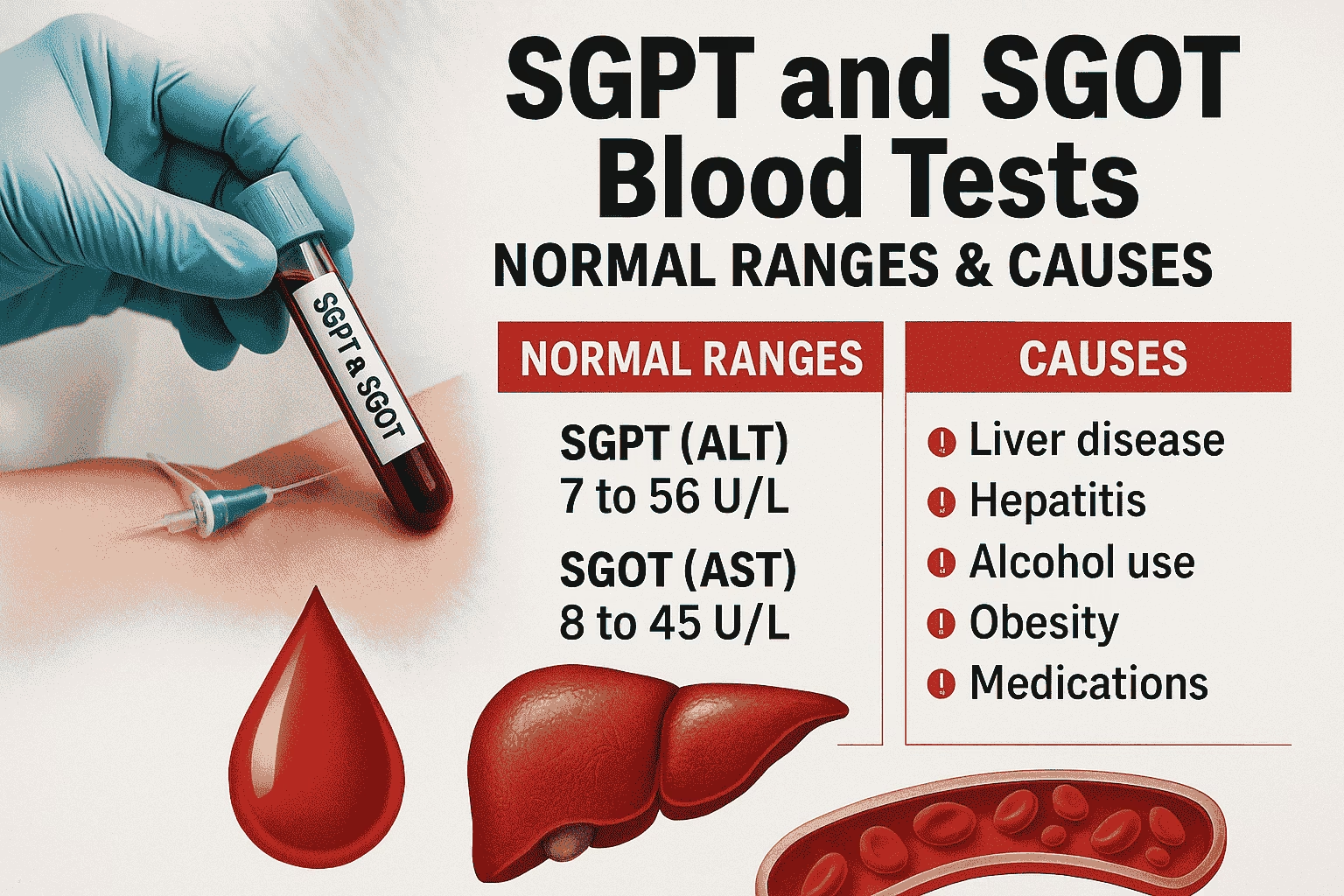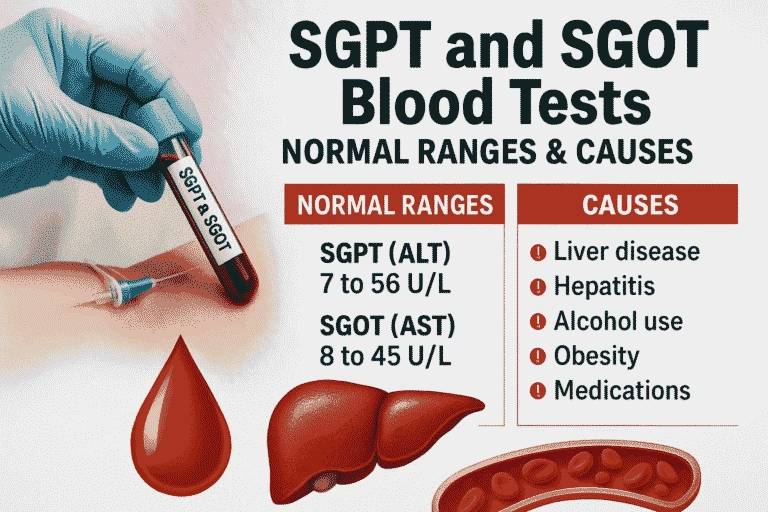
What are SGPT and SGOT, and what are their functions?
SGPT (ALT) and SGOT (AST) are the names of liver enzymes detected in blood tests. ALT (alanine aminotransferase) was previously known as SGPT (serum glutamic-pyruvic transaminase), whereas AST (aspartate aminotransferase) was previously known as SGOT (serum glutamic-oxaloacetic transaminase).
Function of SGPT and SGOT:
These enzymes help liver cells with metabolism (ALT converts proteins into energy and AST processes amino acids). Normally, only small amounts are in the blood, but if liver (or related) cells are damaged, ALT and AST leak into the blood and their levels increase. That is why physicians order SGPT/SGOT tests to detect liver cell injury or disease.
What are the high SGOT and SGPT symptoms
- Nausea or vomiting
- Fatigue or weakness
- Yellowing of skin or eyes (jaundice)
- Stomach or belly pain
- Dark-colored urine
Why might you need an SGPT and SGOT blood test?
In case of certain risk factors:
- High alcohol consumption
- Obesity or overweight
- Diabetes or Metabolic Syndrome
- Regular use of certain medications that can harm the liver
- Family history of liver disease.
Normal SGPT and SGOT ranges
The “normal” range may differ by lab, age, and gender, but typical adult values are roughly:
| Enzyme (Test) | Normal Range (U/L, adults) |
| SGPT (ALT) | 7 – 56 units per liter (U/L) |
| SGOT (AST) | 5 – 40 units per liter (U/L) |
These ranges are approximate.for adult men, ALT levels are typically 7–55 U/L, while AST levels range from 8–48 U/L. Women and children may have slightly different value.Always check with your lab’s report for exact ranges.
Why Doctors Order SGPT and SGOT Tests
Routine Health Check-ups: These tests are frequently included in standard health panels such as Liver Function Tests (LFT) or Comprehensive Metabolic Panels.
Early Detection of Liver Damage: These tests aid in the early detection of liver injury caused by conditions such as hepatitis, alcohol-induced liver damage, or fat buildup (fatty liver disease), allowing for timely treatment.
High or low SGPT/SGOT levels: What do they mean?
High levels of SGPT (ALT) or SGOT (AST) usually indicate liver cell damage or disease. For example, hepatitis, fatty liver (from alcohol or obesity), cirrhosis, liver cancer, or toxins (like certain drugs or poisons) can increase these enzymes. AST is also found in the heart and muscle, so a heart attack or muscle injury can increase SGOT. In general, the higher the level, the more cell damage, but doctors consider the overall clinical picture; a small rise may be harmless, whereas a very high rise is more serious.us
Low levels of SGPT or SGOT are usually not a problem. In fact, low AST and ALT levels are not.Very low ALT is uncommon, but it can occur in vitamin B6 deficiency or other kidney problems.lems
If both SGPT and SGOT are elevated, it typically indicates a liver problem. If only SGOT is elevated and ALT is normal, the problem may not be with the liver. Doctors also consider the SGOT/SGPT ratio; for example, a significantly higher SGOT than SGPT may indicate alcoholic liver damage.
What are the common causes of high SGPT/SGOT levels
Some main reasons for high SGPT/SGOT include:
- Liver infections (viral hepatitis A, B, C, etc.)
- Alcohol or drug damage: Heavy drinking or certain medications (painkillers, statins, etc.) can inflame the liver
- Fatty liver disease: Fat buildup in liver cells (often from obesity or diabetes) raises ALT/AST.
- Cirrhosis or liver scarring: Long-term damage from a variety of causes results in chronically elevated enzymes.
- Gallbladder/bile duct blockage: Conditions such as gallstones can cause an increase in enzyme levels.
- Heart or muscle injury: Because AST (SGOT) is located in the heart or muscle, a heart attack or muscle injury can raise SGOT.
- Other medical conditions: Some infections (mononucleosis), genetic disorders (hemochromatosis), or severe burns can raise these enzymes
When should you get tested?
- Routine check-ups: Many doctors include SGPT/SGOT in regular blood work to catch liver issues early. It’s good practice to have annual or biannual blood tests that check your liver.
- Symptoms of liver disease: If you notice yellow eyes/skin (jaundice), dark urine, light stool, belly pain, nausea, unusual fatigue, or swelling, ask for SGPT/SGOT tests.
- Risk factors present: If you have risk factors, such as heavy alcohol use, obesity, diabetes, a family history of liver disease, or are taking medication that can affect the liver, your doctor may recommend testing.
- Monitoring known liver issues: If you have hepatitis, a fatty liver, or are taking liver-affecting medications, you should have regular SGPT/SGOT tests to monitor your liver’s condition.
How is the SGPT/SGOT test done
The SGPT/SGOT test is performed on a small blood sample.
Procedure .
- A small needle is inserted into a vein.
- Blood is collected in a vial.
- Blood collected is then sent to the lab for observation.
The entire procedure takes only a few minutes and is generally painless, though you may experience a quick pinch.
Associated risk
Slight bruising or pain at the needle site.
The test is generally very safe and low-risk.
What is the preparation for the SGPT/SGOT test?
If the test is ordered in conjunction with other liver panels or blood sugar tests, you may need to fast for 8-12 hours. Your doctor will tell you if fasting is needed. Also, inform your doctor about any medications or supplements you use, as some can affect enzyme levels. Aside from fasting and medication review, no additional preparation is required.
What if your SGPT and SGOT levels are high?
First, don’t be concerned; a mild elevation can occur for a variety of reasons, including intense exercise or natural variation). If your SGPT/SGOT levels are above the normal range, your doctor will interpret them in context. They may repeat the test or order additional tests (such as ultrasound, viral hepatitis tests, or other liver function tests) to determine the cause. Common advice if levels are elevated includes:
- Speak with your doctor. Discuss the possible causes (medication side effects, alcohol use, etc.) and next steps.
- Follow medical advice. Your doctor may recommend lifestyle changes (such as avoiding alcohol and eating a liver-friendly diet) or refer you to a liver specialist.
- Good habits: Cut back or quit drinking, take prescription drugs as prescribed, and keep a healthy weight through exercise and a balanced diet. Taking these actions helps stop additional liver damage.
- Regular monitoring: You may need follow-up tests to see if your levels drop or if a specific liver condition develops.
Even if your levels are high, many people have normal lives after treatment. Early detection provides the best chance of resolving the issue, which is why follow-up is crucial.
Conclusion
SGPT and SGOT tests are simple blood tests that reveal a great deal about liver health. Regularly checking these enzymes—especially if you have symptoms or risk factors—can help you detect liver problems early. Maintaining a healthy lifestyle (balanced diet, exercise, and moderate alcohol consumption) also helps to keep your liver enzymes within normal limits. Remember that regular health check-ups and discussing any concerns with your doctor are essential for maintaining good liver and overall health.
FAQs
What do SGPT and SGOT stand for, and what do they check?
SGPT stands for serum glutamic-pyruvic transaminase (ALT), and SGOT stands for serum glutamic-oxaloacetic transaminase (AST). Both enzymes are produced by the liver. A blood test determines the levels of ALT and AST in your blood. High levels typically indicate liver cell damage.
What are the typical ranges for SGPT and SGOT?
Normal ranges vary slightly between labs. Typical adult ranges are about SGPT (ALT): 7–56 U/L and SGOT (AST): 5–40 U/L. Your lab report will include a specific range. Values that exceed the normal range may require further investigation.
What does it mean to have a high SGPT/SGOT?
High SGPT/SGOT levels frequently indicate that the liver cells are inflamed or injured. The most common causes are hepatitis (viral liver infection), fatty liver (due to alcohol or obesity), cirrhosis (scarring), and certain medications. SGOT (AST) levels can also rise after a heart attack or muscle injury. Your doctor will combine the results with other tests to determine the exact cause.
How should I prepare for the SGPT/SGOT blood tests?
If the test is part of a comprehensive panel, you may be asked to fast (8-12 hours without eating or drinking). Otherwise, simply notify your doctor about any medications or supplements you take. The test consists of a quick blood draw from your arm. There is little risk, with the exception of minor bruising or pain at the needle site.
Discover more from The Vigyan Chronicles
Subscribe to get the latest posts sent to your email.



